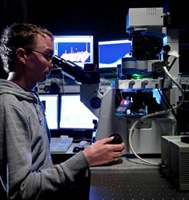Members Login

Channels
Special Offers & Promotions
The Nanoscopy Group of Dr Volker Deckert applies JPK platform of optical technologies in the development of TERS
 JPK
Instruments, a world-leading manufacturer of nanoanalytic instrumentation for
research in life sciences and soft matter, reports on the research and
technique development activities of the Institute of Photonic Technology (IPHT)
in Jena under the direction of Dr Volker Deckert.
JPK
Instruments, a world-leading manufacturer of nanoanalytic instrumentation for
research in life sciences and soft matter, reports on the research and
technique development activities of the Institute of Photonic Technology (IPHT)
in Jena under the direction of Dr Volker Deckert.At the Institute of Photonic Technology (IPHT) in Jena, light is the central focus of research and development. The new IPHT sees photonics as the most important key technology of the 21st century. It is guaranteed to play a leading role in the fields of information technology and communications, security, material science, life science and health.
Dr Volker Deckert is the head of the Nanoscopy department which utilizes instrumental methods in the development of molecular spectroscopic methods with the highest spatial resolution. Central to this program has been the use of tip-enhanced Raman scattering, TERS, where JPK's NanoWizard® systems and Tip-Assisted Optics module have provided a platform in the development of these experimental methods. In many cases, the structural sizes of components are below the capabilities of normal optical microscopic or spectroscopic techniques. Optical near-field microscopy in combination with Raman spectroscopy pushes the achievable resolution significantly below the diffraction limit of standard instruments. The goal of their work is the advancement of TERS to become an accessible and sensitive tool for the analysis of surfaces and boundaries under ambient conditions. Applications are carefully selected. For example, heterogeneous catalytic reactions are studied because such application-oriented experiments may be used to verify and improve the functionality of the instrument and to demonstrate its practicality for "real" problems.
Recent examples from the literature include a paper published in SMALL, January 2011, which reported Nanometer-Sized Lipid and Protein Domains on a Single Cell. Their existence was confirmed with highly resolved lateral images combined with direct spectroscopic evidence. TERS was used as a label-free, nondestructive method for the direct mapping of nano¬meter-sized lipid and protein domains on the surface of a single cell. Spectral processing allowed the analysis and visualization of the different cellular surface components down to a spatial resolution of 10-20 nm.
Another excellent example of this technique in action was published in the Journal of Biophotonics, June 2010. Here, biochemical imaging below the diffraction limit was demonstrated with the cellular membrane being probed in relation to other structures using TERS. First, a vibrational mapping on the nanometer scale was performed on a protein- (streptavidin) labeled & supported phospholipid film using TERS. In this instance, a TERS spectral map was measured on the biomembrane model using a step size far below the diffraction limit. Considering the model composition, spectra were classified as either typical for lipids, proteins or both simultaneously in a qualitative manner. Subsequently, the spectroscopic information was assigned with respect to the topographic features. Since a spatial differentiation between different compositional domains is difficult to achieve by topographic features only, the combination of morphology and spectral data enables a much more detailed characterization of biomembranes.
Commenting on his interactions with JPK over the years, Dr Deckert said "Since 2002, all our TERS experiments relied on instruments based on JPK AFMs. In particular, the joint development coupling and synchronizing both the spectroscopy and scanning probe parts proved to be extremely robust and reliable. JPK's support was fast and thorough whenever a specific adaption to a new Raman microscope or detection scheme was required."
Working with Dr Deckert has been of great help to JPK Founder and CTO, Torsten Jähnke. Speaking recently in Berlin, Jähnke said "The development of TERS required a tip-scanning system with ready-access to the optics and the multiple electronic signal possibilities. Understanding Dr Deckert's needs have helped us build in the required versatility and flexibility in the development of our latest systems culminating in the announcement of our new NanoWizard®3 NanoOptics system."
JPK develop, engineer and manufacture instrumentation in Germany to the world-recognized standards of German precision engineering, quality and functionality.
For further details of the NanoWizard® AFM and other products in the JPK family of bio and nanoscale instrumentation, please visit the JPK web site (www.jpk.com) or Facebook (www.jpk.com/facebook).
Media Partners


